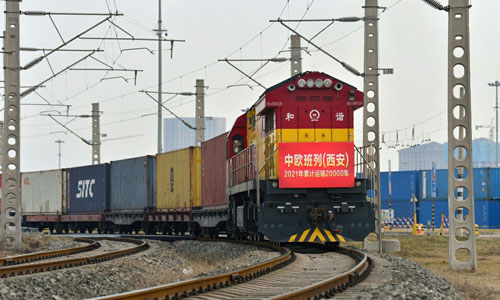Driven by a resilient global demand for Chinese goods ranging from personal protective equipment (PPE) to home appliances, China-Europe freight trains, which have become a pillar for the trade for countries along the Belt and Road when other transports were disrupted by the COVID-19 outbreak, have seen record growth in the early two months of the year.
A total of 2,213 freight trains were dispatched between cities in China and Europe in January and February combined, up 96 percent year-on-year, and the amount of goods delivered was also significant at 209,000 TEUs (Twenty-foot Equivalent Units), up 106 percent year-on-year, according to the report the China State Railway Group Co (China Railway) sent to the Global Times over the weekend.
Since last May, more than 1,000 trains have been dispatched each month for 10 consecutive months, the report said.
This came as the number of trains running across last year was 12,406, an increase of 50 percent year-on-year, exceeding the “10,000” mark for the first time and 7.3 times than that of 2016, Zhao Chenxin, a spokesperson of the National Development and Reform Commission, told a press conference in January.
Bucking the trend
BRI related countries have played an important supporting role in the sustained improvement of China’s foreign trade.
In January and February, China’s exports to the BRI related countries reached 1.62 trillion yuan ($249 billion), a year-on-year increase of 23.9 percent, China Customs said on Sunday.
Zhao Juan, research fellow with the China Railway Economic and Planning Research Institute, told the Global Times on Sunday that the China-Europe freight train, an iconic logistic channel for the Belt and Road, has been under rapid growth since last year for it delivers goods faster and cheaper than ships and planes.
As shipping freight rates have largely increased due to a container shortage created by a backlog at foreign ports, the transport time and fees of the train remain relatively stable.
Despite congestions abroad, trains only take 18 days to arrive in Germany, shorter compared to around 35 days by sea, a trader told the Global Times.
“China-Europe freight trains are becoming very popular, especially after the suspension of some transport services by sea and air due to the ongoing outbreak,” a staff at Chengdu International Railway Logistics Service told the Global Times over the weekend, noting that even the most advantageous shipping prices have been rising precipitously, making it more expensive than the freight trains these days.
Driven by the booming logistic demand, the trains have also been booked to such an extent that many providers have even introduced lottery system to allocate trains and containers, media reports.
The China-Europe freight trains have performed better in particular areas including Yiwu in East China’s Zhejiang Province – commonly referred to as the world supermarket.
Over 200 China-Europe freight trains have been dispatched from Yiwu to European cities in the first two months of this year, an unprecedented increase of 336 percent year-on-year, Zhao Hengchao, a director with the port customs at Yiwu West Train Station, told the Global Times on Sunday.
The significant jump had to do with the backlog of goods that were not able to be delivered last year, said Zhao.
However, the container shortages for the freight trains have been eased despite the strong demand.
“The number of containers needed for the train have reduced by 15 percent compared with last December since many new containers have been made and some containers stranded abroad have been sent back,” said Zhao.
One conspicuous trend is the changing type of goods delivered via the train from mainly PPE last year to other daily commodities such as home appliances and clothing these days, according to the port customs.
Global cooperation necessary
As the cross-border freight train sees a continuous record-breaking growth, other issues such as the transport capacity limit at ports has become a potential hurdle for further improvement.
To further strengthen the transport service for the Belt and Road for sustainable growth on trade, China Railway is expanding capacity of border ports including Khorgas port in Northwest China’s Xinjiang Uygur Autonomous Region and Erenhot port, North China’s Inner Mongolia Autonomous Region by building new arrival and departure lines, replacement lines and loading and unloading facilities, according to the report that China Railway sent to the Global Times over the weekend.
However, the growth of rail freight routes required collaboration both home and abroad.
“There is little room for the China-Europe freight train to shorten transportation time, because the transportation speed is still the same, and it may be extended for only a day or two in special periods, because the overseas ports have become congested due to overcapacity,” a source close to the customs told the Global Times on condition of anonymity.
China Railway has pledged to continue to deepen international through transport cooperation by organizing video conferences of expert working groups to strengthen international cooperation and coordination and ensure the time-efficiency of freight trains, the Global Times learned.
Experts said that all ports are now undergoing extensive reconstruction, and in coordination with foreign countries, the number of China-Europe freight trains is expected to continue steady growth in the future.










